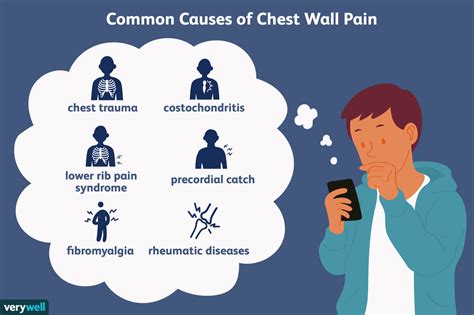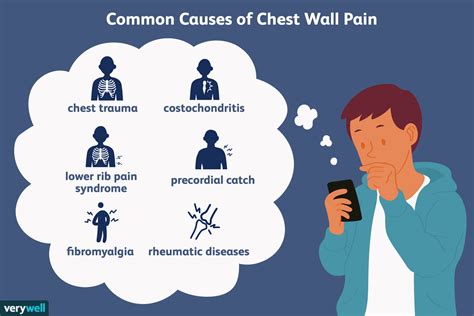Intro
Alleviate musculoskeletal chest pain with 5 effective methods, including exercises, stretches, and stress management techniques to relieve thoracic and rib cage discomfort, improving posture and overall musculoskeletal health.
Musculoskeletal chest pain is a common complaint that can be caused by a variety of factors, including poor posture, muscle strain, and overuse. This type of pain can be debilitating and affect daily activities, making it essential to find effective ways to manage and alleviate it. In this article, we will explore five ways to ease musculoskeletal chest pain, providing readers with practical tips and strategies to improve their overall well-being.
The importance of addressing musculoskeletal chest pain cannot be overstated. When left untreated, this condition can lead to chronic pain, decreased mobility, and a reduced quality of life. Furthermore, musculoskeletal chest pain can be a symptom of an underlying condition, such as a herniated disk or osteoarthritis, making it crucial to seek medical attention if the pain persists or worsens over time. By understanding the causes and consequences of musculoskeletal chest pain, individuals can take proactive steps to prevent and manage this condition.
Musculoskeletal chest pain can be caused by a range of factors, including muscle imbalances, poor posture, and repetitive strain. For instance, individuals who work at a desk or engage in activities that involve heavy lifting may be more prone to developing musculoskeletal chest pain. Additionally, factors such as stress, anxiety, and poor sleeping habits can exacerbate this condition, making it essential to adopt a holistic approach to managing musculoskeletal chest pain. By addressing the underlying causes and incorporating lifestyle changes, individuals can reduce their risk of developing this condition and improve their overall health.
Understanding Musculoskeletal Chest Pain

Causes of Musculoskeletal Chest Pain
The causes of musculoskeletal chest pain are diverse and can be categorized into several key areas. These include: * Muscle imbalances: Weak or tight muscles in the chest and shoulder region can lead to poor posture and altered movement patterns, resulting in musculoskeletal chest pain. * Poor posture: Prolonged sitting or standing in a slouched position can put strain on the muscles and joints in the chest region, leading to pain and stiffness. * Repetitive strain: Engaging in activities that involve heavy lifting, bending, or twisting can cause repetitive strain on the muscles and joints, leading to musculoskeletal chest pain. * Underlying conditions: Herniated disks, osteoarthritis, and other underlying conditions can cause musculoskeletal chest pain, making it essential to seek medical attention if the pain persists or worsens over time.5 Ways to Ease Musculoskeletal Chest Pain

Benefits of Physical Therapy
Physical therapy is a highly effective way to ease musculoskeletal chest pain, offering a range of benefits, including: * Improved flexibility and range of motion * Strengthened muscles and joints * Enhanced posture and movement patterns * Reduced inflammation and pain * Improved overall well-being and quality of lifePreventing Musculoskeletal Chest Pain

Importance of Early Intervention
Early intervention is crucial for preventing and managing musculoskeletal chest pain. This includes: * Seeking medical attention if pain persists or worsens over time * Addressing underlying conditions, such as herniated disks or osteoarthritis * Incorporating lifestyle changes, such as improving posture and engaging in physical therapy * Practicing stress-reducing techniques and modifying daily activitiesConclusion and Next Steps

We invite readers to share their experiences and tips for managing musculoskeletal chest pain in the comments below. Additionally, we encourage readers to share this article with others who may be struggling with this condition, helping to raise awareness and promote effective management strategies. By working together, we can reduce the burden of musculoskeletal chest pain and improve the overall health and well-being of individuals and communities.
What are the common causes of musculoskeletal chest pain?
+Musculoskeletal chest pain can be caused by a range of factors, including poor posture, muscle strain, and overuse. Other underlying conditions, such as herniated disks or osteoarthritis, can also contribute to this condition.
How can I prevent musculoskeletal chest pain?
+Preventing musculoskeletal chest pain involves maintaining good posture, engaging in regular exercise and physical activity, practicing stress-reducing techniques, and modifying daily activities to reduce strain and repetition.
What are the benefits of physical therapy for musculoskeletal chest pain?
+Physical therapy can help alleviate musculoskeletal chest pain by improving flexibility and range of motion, strengthening muscles and joints, enhancing posture and movement patterns, and reducing inflammation and pain.
How can I manage musculoskeletal chest pain at home?
+Managing musculoskeletal chest pain at home involves practicing stress-reducing techniques, modifying daily activities to reduce strain and repetition, and incorporating lifestyle changes, such as improving posture and engaging in physical therapy.
When should I seek medical attention for musculoskeletal chest pain?
+Individuals should seek medical attention if musculoskeletal chest pain persists or worsens over time, or if they experience accompanying symptoms, such as numbness, tingling, or weakness.
